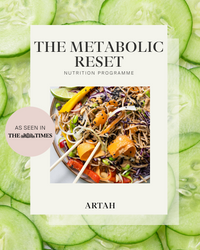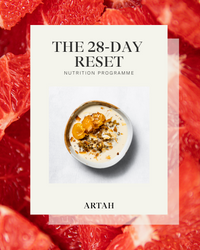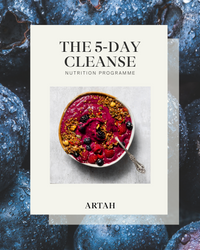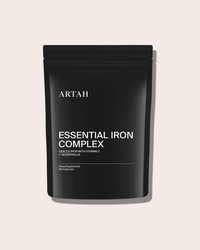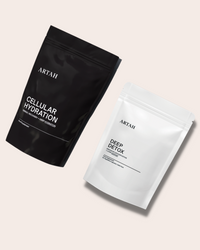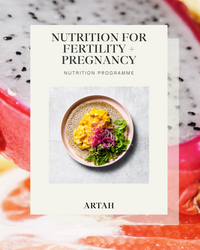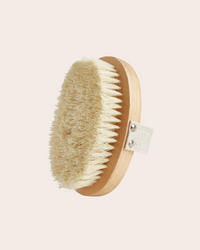A Targeted Approach to Moody PMS + Painful Periods
How diet, lifestyle and supplements can dramatically improve your symptoms.
Cycle syncing is all the rage, and guess what – it works. So, what does it actually mean? Simply put, it means aligning your lifestyle, diet, workouts, and supplements to your monthly hormonal cycle. When you tune into your cycle you’ll start to notice a distinctive pattern with how your energy, mood, focus and cravings fluctuate but it’s not very often that we modify our lifestyle to make up for this. Cycle syncing is an empowering practice, especially when it’s comes to tackling PMS, which can often feel incredibly disruptive to our lives.
So, it’s time to start working WITH your body instead of against it. In part one of our focus on hormones, we’re tackling mood-related PMS + painful periods.
PMS
PMS is a broad term that refers to the physical and emotional changes that can occur leading up to menstruation. The list of symptoms is LONG, but amongst the most common are anxiety, tearfulness, irritability/anger, social withdrawal, insomnia, appetite changes and cravings, breast tenderness, headache, fatigue, fluid retention, acne flare ups, poor concentration and joint/muscle pain.
Conquering your PMS will take a couple of cycles and the good news is, the right combination of dietary, lifestyle and supplement tweaks can do you wonders (to learn more, join our cycle syncing forum this month). As we charge through the luteal phase of our cycle, we’re rapidly using more of everything – vitamins, minerals, fatty acids and antioxidants – and hormonal changes are causing changes every day, so modifying how we move, eat, and supplement is the best way to support. Let’s look at the most common groups of symptoms.
Moody PMS — Anxiety, tearfulness + low mood.
LIFESTYLE HACKS:
— Flexing your exercise is important and the best type for you will be dependent on your base level of fitness. We’ll get more in depth on this in the cycle synching forum, but the best place to start is being more intuitive with how you exercise rather than trying to force what you think you should do. Longer, slower cardio has been shown to reduce mood related PMS symptoms.
— Light therapy. Not the cheapest option, but definitely a good investment for your overall health if PMS is disrupting your life (they’re also great for SAD, general energy, immunity and skin, so worth the investment over time). Our favourite is the Joov.
— Meditation + breathwork, both of which can reduce symptoms and improve stress.
SUPPLEMENT SAVIOURS:
— Enhanced Nootropics. Magnesium and B Vitamins are rapidly used up as we move into menstruation and are intimately involved in our mood. Vitamin B6 is especially important with neurotransmitter production, and with serotonin falling to its lowest point in week 4 this is especially important. As a bonus, Enhanced Nootropics has a good dose of 5 HTP, which has been shown to improve mood, anxiety, sleep and appetite. Yes please. Take this for 3 full cycles and then move to week 3-4 only if you’re feeling great.
NUTRITION NO-NO'S:
— Can you guess? Alcohol is a PMS killer. With serotonin and b vitamins already at their lowest, alcohol may feel nice in the moment but will wreak havoc after the fact. If your mood-related symptoms seriously affect your lifestyle, keep alcohol out of the luteal phase (or at least minimised) and enjoy it in the follicular phase until you feel more balanced.— Excess caffeine can exacerbate mood symptoms, so see if reducing it helps. You can also lessen the effects of your cup of Joe by having it on a full stomach.
WHAT TO WATCH OUT FOR:
— PMDD (premenstrual dysphoric disorder) is a more extreme form of PMS and can warrant medical attention. If your symptoms include depression that severely interrupts your normal life or suicidal thoughts, it’s important to seek support from your doctor.
CRAMPS + PERIOD PAIN
Unbeknownst to most, menstruation is an inflammatory process, so it’s no wonder that cramps can often get the best of us. When fertilisation does not occur, the luminal layer of the endometrium is shed only to repair again and prepare for implantation the next month. During this process, prostaglandins – pro-inflammatory compounds - cause inflammation, smooth muscle contraction and clotting. Studies have shown that people with extremely painful periods have higher levels of prostaglandins, and whist a little period pain is normal, if you’re doubling up on painkillers for days then there’s something that’s out of whack.
LIFESTYLE HACKS:
— Lavender, sage and cinnamon aromatherapy oils can reduce pain when applied to the abdomen.— Yoga can relieve menstrual discomfort and if you feel up to it, so can light cardio.
— Low level heating pads have been shown in studies to be as effective as Ibuprofen, without the gut damaging side effects.
SUPPLEMENT SAVIOURS:
— Essential GLA. This is our go-to for menstrual pain because of its anti-inflammatory action. Start with 1 per day once you hit the luteal phase and if your pain is particularly bad, up it to 2 when your cramps start.
— Essential Omegas. Another anti-inflammatory hero, omega 3’s also reduce inflammation and help regulate hormones. Pair this with GLA for best results.

NUTRITION NO-NO'S:
— If you suffer from extreme menstrual pain, this is not the best week for alcohol, which will worsen inflammation, pain and associated fatigue.— Processed meats + ultra-processed foods. These are never the most healthful food to choose, but the chemicals, preservatives and flavourings in these foods have been shown to increase inflammatory markers in the blood.
WHAT TO WATCH OUT FOR:
— Severe period pain can be a sign of an underlying condition like endometriosis or adenomyosis, so if your pain is unbearable and gets in the way of your daily life you should seek advice from your doctor. Other signs of these conditions include painful intercourse, pain with urination or bowel movements, and excessive bleeding.
This article is for educational purposes only and the implementation of the theories and practices discussed is at the sole discretion of the individual. All advice given is not a substitute for medical advice, diagnosis, or treatment. If you have any concerns about your health, you should speak with your physician.














